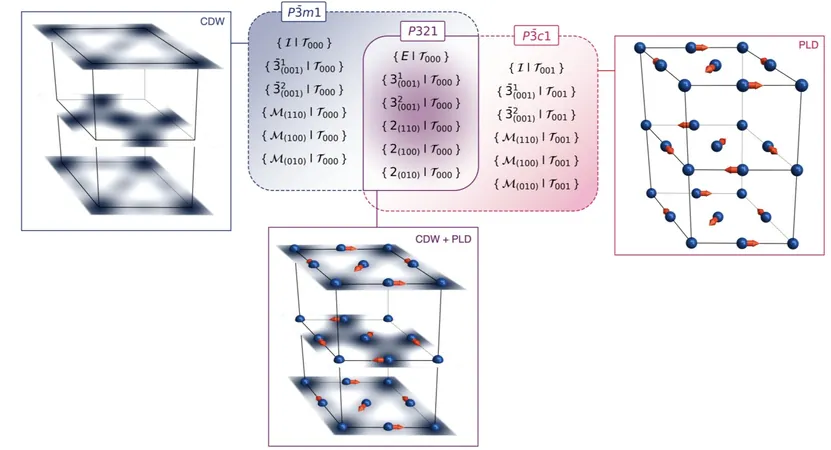
Scientists Uncover the Mysterious Mechanism Behind Chiral Charge Density Waves in Titanium Diselenide (TiSe2)
2024-11-14
Author: Arjun
Groundbreaking Discoveries in TiSe2 Research
In a groundbreaking study, researchers from Pohang University of Science and Technology, Argonne National Laboratory, and affiliated organizations have shed light on the enigmatic chiral charge density waves in titanium diselenide (TiSe2). This work, published in Nature Physics, is not just a mere academic exercise; it unravels a significant aspect of materials science and opens doors to understanding similar phenomena across various fields, including chemistry and biology.
The Role of Chirality
Chirality, the property of asymmetry in the arrangement of molecules or structures, plays a vital role in many scientific disciplines. The concept has implications ranging from the function of biological systems to the behavior of subatomic particles. "Chirality is ubiquitous in nature," noted B. J. Kim, the senior author of the study, emphasizing its extensive presence in both physical and biological realms.
Challenges in Understanding TiSe2
While TiSe2 has been under study since the 1970s, the current research focused on a crucial inconsistency within its established structural models. Previously, researchers believed that the electronic properties of TiSe2 were congruent with its known crystal structures, which conform to certain symmetries. However, the new findings suggest that the electronic structure exhibits chirality—a deviation that calls into question prior assumptions.
The Research Approach
Kim and his team conducted an extensive theoretical symmetry analysis to explore how distortions in the lattice structure affected the material's electronic properties. They discovered that the lattice distortions linked to charge density waves lead to a change in space group symmetry. Fascinatingly, these variations also encouraged further lattice distortions, revealing a complex interplay between structure and electronic behavior.
Advanced Experimental Techniques
Employing advanced techniques such as Raman scattering and inelastic X-ray scattering, the research team pinpointed subtle changes in lattice vibration modes. These methods offered insights into how phonons—the quanta of lattice vibrations—respond to the formation of charge density waves, thereby allowing researchers to infer changes in symmetry without the limitations of traditional diffraction methods.
Broader Implications of the Study
The implications of this research are staggering. As Kim concluded, "We not only delineated the intricacies of chirality in TiSe2 but established a broader framework for understanding how such mechanisms manifest across other materials." This discovery not only resolves long-standing discrepancies in understanding TiSe2 but also serves as a stepping stone for exploring chirality in other systems, from novel materials to biological entities.
Conclusion and Future Directions
This study marks a pivotal moment in condensed matter physics and material science. As the pursuit of knowledge continues, one cannot help but wonder: what other secrets lie hidden within the structures of seemingly ordinary materials? Keep an eye on this field—it may just lead to the next big breakthrough in science!


 Brasil (PT)
Brasil (PT)
 Canada (EN)
Canada (EN)
 Chile (ES)
Chile (ES)
 Česko (CS)
Česko (CS)
 대한민국 (KO)
대한민국 (KO)
 España (ES)
España (ES)
 France (FR)
France (FR)
 Hong Kong (EN)
Hong Kong (EN)
 Italia (IT)
Italia (IT)
 日本 (JA)
日本 (JA)
 Magyarország (HU)
Magyarország (HU)
 Norge (NO)
Norge (NO)
 Polska (PL)
Polska (PL)
 Schweiz (DE)
Schweiz (DE)
 Singapore (EN)
Singapore (EN)
 Sverige (SV)
Sverige (SV)
 Suomi (FI)
Suomi (FI)
 Türkiye (TR)
Türkiye (TR)
 الإمارات العربية المتحدة (AR)
الإمارات العربية المتحدة (AR)